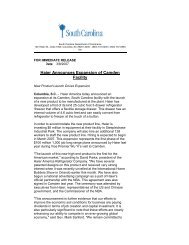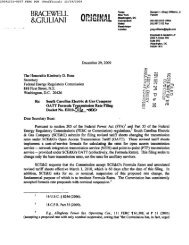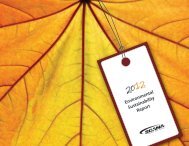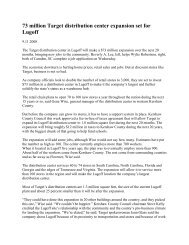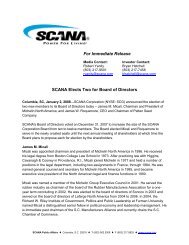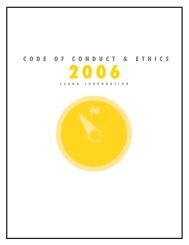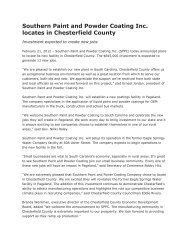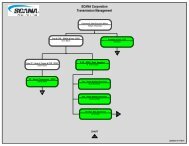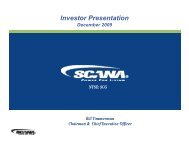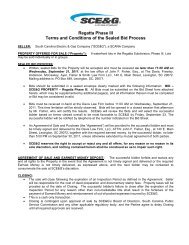10-K - SCANA Corporation
10-K - SCANA Corporation
10-K - SCANA Corporation
You also want an ePaper? Increase the reach of your titles
YUMPU automatically turns print PDFs into web optimized ePapers that Google loves.
Table of Contents<br />
Environmental<br />
In December 2009, the EPA issued a final finding that atmospheric concentrations of GHG endanger public health and<br />
welfare within the meaning of Section 202(a) of the CAA. The rule, which became effective in January 20<strong>10</strong>, enables the EPA to<br />
regulate GHG emissions under the CAA. The EPA has committed to issue new rules regulating such emissions in 2012. Consolidated<br />
SCE&G expects that any costs incurred to comply with GHG emission requirements will be recoverable through rates.<br />
In 2005, the EPA issued the CAIR, which required the District of Columbia and 28 states, including South Carolina, to<br />
reduce nitrogen oxide and sulfur dioxide emissions in order to attain mandated state levels. CAIR set emission limits to be met in two<br />
phases beginning in 2009 and 2015, respectively, for nitrogen oxide and beginning in 20<strong>10</strong> and 2015, respectively, for sulfur dioxide.<br />
SCE&G and GENCO determined that additional air quality controls would be needed to meet the CAIR requirements. On July 6,<br />
2011 the EPA issued the Cross-State Air Pollution Rule (CSAPR). This rule replaced CAIR and the Clean Air Transport Rule<br />
proposed in July 20<strong>10</strong> and aimed at addressing power plant emissions that may contribute to air pollution in other states. CSAPR<br />
requires states in the eastern United States to reduce power plant emissions, specifically sulfur dioxide and nitrogen oxide. On<br />
December 30, 2011, the United States Court of Appeals for the District of Columbia issued an order staying CSAPR and reinstating<br />
CAIR pending resolution of an appeal of CSAPR. Air quality control installations that SCE&G and GENCO have already completed<br />
should assist the Company in complying with the Cross-State Air Pollution Rule and the reinstated CAIR. The Company will<br />
continue to pursue strategies to comply with all applicable environmental regulations. Any costs incurred to comply with this rule or<br />
other rules issued by the EPA in the future are expected to be recoverable through rates.<br />
In 2005, the EPA issued the CAMR which established a mercury emissions cap and trade program for coal-fired power<br />
plants. Numerous parties challenged the rule and, on February 8, 2008, the United States Circuit Court for the District of Columbia<br />
vacated the rule for electric utility steam generating units. In March 2011, the EPA proposed new standards for mercury and other<br />
specified air pollutants. The rule, which becomes effective on April 16, 2012, provides up to four years for facilities to meet the<br />
standards. The rule is currently being evaluated by the Company. Any costs incurred to comply with this rule or other rules issued by<br />
the EPA in the future are expected to be recoverable through rates.<br />
SCE&G has been named, along with 53 others, by the EPA as a PRP at the AER Superfund site located in Augusta, Georgia.<br />
The PRPs funded a Remedial Investigation and Risk Assessment which was completed and approved by the EPA and funded a<br />
Feasibility Study that was completed in 20<strong>10</strong>. A clean-up cost has been estimated and the PRPs have agreed to an allocation of those<br />
costs based primarily on volume and type of material each PRP sent to the site. SCE&G’s allocation did not have a material impact on<br />
its results of operations, cash flows or financial condition.<br />
SCE&G maintains an environmental assessment program to identify and evaluate its current and former operations sites that<br />
could require environmental clean-up. As site assessments are initiated, estimates are made of the amount of expenditures, if any,<br />
deemed necessary to investigate and remediate each site. These estimates are refined as additional information becomes available;<br />
therefore, actual expenditures could differ significantly from the original estimates. Amounts estimated and accrued to date for site<br />
assessments and clean-up relate solely to regulated operations. SCE&G defers site assessment and cleanup costs and expects to<br />
recover them through rates.<br />
SCE&G is responsible for four decommissioned MGP sites in South Carolina which contain residues of by-product<br />
chemicals. These sites are in various stages of investigation, remediation and monitoring under work plans approved by DHEC.<br />
SCE&G anticipates that major remediation activities at these sites will continue until 2014 and will cost an additional $8.3 million.<br />
SCE&G expects to recover any cost arising from the remediation of MGP sites through rates and insurance settlements. At<br />
December 31, 2011, deferred amounts, net of amounts previously recovered through rates and insurance settlements, totaled<br />
$24.9 million and are included in regulatory assets.<br />
136



